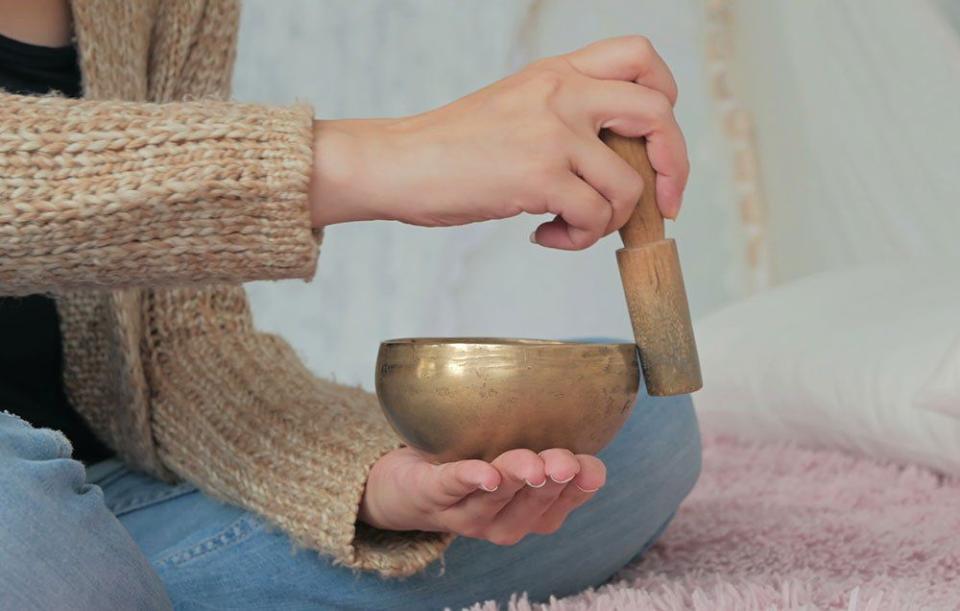I Tried Sound Meditation To Relieve My Stress—Here Are 5 Surprising Things I Learned

One of the benefits of working at a health and wellness focused company like Rodale, is sometimes you're presented with surprising options, like attending a sound healing workshop in the middle of the afternoon.
I had vaguely heard of sound healing before at my yoga studio, and some instructors had even occasionally closed our classes with a few sonorous notes from a singing bowl during savasana, but I hadn't thought much of the practice beyond this.
(Want to pick up some healthier habits? Sign up to get healthy living tips, weight loss inspiration, slimming recipes and more delivered straight to your inbox!)
To me, it seemed like something that was a nice idea, but probably didn't have much effect: like the spray bottle of palo santo I tried on my office (It's a cute bottle, and not a bad smell—but no refreshed healing vibes or bursts of energy whatsoever have come along with my occasional spritizing of it). But, after actually attending a sound healing, I changed my tune in a hurry.
Sound healing, or vibroacoustic therapy, works by using certain sound frequencies and waves to reduce stress and anxiety, and to create a meditative and relaxing state.
MORE: 6 Simple Ways You Can Use Crafting To Relieve Stress And Anxiety
"Science has shown that every part of our body, the organs, the fluids all have their own resonance or frequency. It is said when those resonances are 'out of tune,' whether due to stress, illness or environmental factors, this can lead to disease. Sound healing is a way of bringing the body back into harmony and into its true resonance," says Andrea Brock, owner of Andrea Brock Healing, and a Reiki master who led my sound healing workshop. "The process of coming back to center is like a feeling of coming home and can feel like a sense of relief. Even just listening to your favorite song, one that makes you feel alive, is a form of sound healing."
This popular music logic actually made tons of sense to me. I am a music junkie, and when I get deeply obsessed with a song, it's like it seeps into my being and calls forth something I can't access without listening to it. This effect has proven true for almost everyone at some point—as Brock says, we all have that song that makes us feel alive, and that will actually, physically get our blood rushing and our adrenaline pumping—so why wouldn't carefully calibrated soothing and ancient sounds also be able to influence the body, instead creating healing and a medititative state: a feeling, like Brock says, of coming home.
It's also a phenomenon that's been studied more frequently over the years. The Journal of Physical Therapy published a study indicating that vibroacoustic therapy could help nursing home residents with depression and improved relaxation, and it's also been studied to assist with pain management.
MORE: How To Fight Depression With Your Diet
Here's what I learned when I tried sound meditation for the first time.

1. It doesn't matter where you do it.
Because of the circumstances, I had my sound healing done in a large vaulted office room in a straightbacked chair. I imagined that this would somehow dim my experience, which I figured should be in a candlelit Himalayan salt cave or at the very least on a meditation pillow.
But once it started, I may as well have been on the moon. I closed my eyes and meditated throughout the whole workshop, so it didn't matter where I was at all—only that I was focusing on the sounds, which was honestly hard not to do, with them reverberating around me, and what felt like, through me.
MORE: 6 Things That Happened When I Tried Meditating Every Day For A Month
2. It's more complicated than you think.
"I feel that sound healing can be underestimated," says Brock. And she was right: I had no idea there were so many tools and rhythms involved in the process. Brock used an array of Tibetan singing bowls, tuning forks, rattles, a drum, a rain stick, as well as toning with her voice, which blended well with the instruments.
The best part is, you don't even need to find a class to experiment with sound meditation. There are a variety of beautiful and effective Tibetan singing bowls and tuning forks available online, and we love this Chilean cactus rainstick.
When Brock started with the bowls in class, I felt a heavy calm coupled with an emotional pull deep in my gut. It was a deep reverberation, and it seemed to go through me. It was like when you hear a song which suddenly reminds you of everything you love, and for that moment you forget your anxieties and stress and all the checklist items you may have forgotten to do today, because you are reminded in such a strong way of how beautiful the world is.
Smaller chimes, Brock's singing, and the rain stick mixed in to create a kind of journey through sound. I didn't have to try to focus like I usually do in meditation: the sounds made me feel like I was floating.
3. Whether you do it in a group or privately makes a big difference.
I did my sound healing in a group workshop of about 15 women, but I want to go back and try out a private session.
"In a private session you get the full attention of the practitioner and as a result it can be a more intense experience," says Brock, "Group sessions can also be powerful as you get caught in what can be described as a wave of energy that the collective group is experiencing. It can heighten and magnify your experience."
For me, the group session was a boon because it made me feel a bit less silly about the whole thing. It was okay for me to let go and really dig into the sound, because everyone else there was doing it too. It was hard to feel silly and skeptical when we had all decided to do this together. Being in a group also helped me evaluate that sense of sarcastic doubt I so typically adopt towards things like this: why not be open instead?

4. You don't have to do it all the time for it to have a powerful effect.
How often you tune into sound meditation is up to you–you can do it often or occasionally, says Brock: it all depends on what is going on in your life, and how it fits into your other routines.
"For those who are under a lot of stress or have experienced trauma, this is a way of releasing emotions," says Brock. "So they may choose to experience this method of healing weekly for a short time period. Others may choose to have sessions just monthly or quarterly."
I think I would include sound meditation occasionally with a range of other self-care practices I try to have, whether it's taking myself for a walk in the middle of the day to get some sunshine, going to a yoga class, or remembering to take time for prayer, meditation, and reflection.
MORE: 5 Meditations You Can Do At Your Desk (Yes, Right Now)
Here's the ultimate yoga pose for stress relief:
5. You'll feel like you just got wrung out—in the best way possible.
After the experience, I felt moved and uplifted, and also like I had just gone somewhere far away and come back. The sounds were wordless, but they had a power and certainty to them. It reminded me of Faulkner, in his 1950 Nobel Prize speech, who used the concept of a bell and sound when talking about the end of time, saying, "when the last dingdong of doom has clanged and faded from the last worthless rock hanging tideless in the last red and dying evening, that even then there will still be one more sound."
It also now makes more sense that some of my favorite music has words I can't understand. It's not just classical or instrumental music, either (though John Williams playing Asturias blows my mind every time I hear it): why do I get chills when I listen to the ethereal Icelandic rock of Sigur Rós and shell out money for their concerts when I have no idea what they're saying?
Brock says the most powerful part of sound healing practice for her is "the sense of wonder and surprise from those experiencing the healing and seeing a person who looks like they have just had the weight of the world lifted off their shoulders."
It's possible that I just have a strong affinity for sound, but I'm not the only person I've heard of that has had such a strong reaction to the bowls. It's not unheard of for people to cry during a sound healing meditation class, even in a group session. Perhaps because there is something so ancient and wordless about sound, and all music: it has a way of reminding you of everything you tend to forget.
The article I Tried Sound Meditation To Relieve My Stress—Here Are 5 Surprising Things I Learned originally appeared on Rodale’s Organic Life.
You Might Also Like

